Avenue Ledru Rollin
Ledru-Rollin Avenue is a street situated in the neighbourhoods of Quinze-Vingts of the 12th arrondissement and Sainte-Marguerite and Roquette of the 11th arrondissement of Paris.
 | |
| Former name(s) | Rue Saint-Claude, avenue Lacuée |
|---|---|
| Length | 1540 metres |
| Width | 30 metres |
| Location | Paris, France |
| Arrondissement | 11th & 12th |
| Quarter | Quinze-Vingts, Sainte-Marguerite, and Roquette |
| Postal code | 75012, 75011 |
| Nearest metro station | |
| Coordinates | 48.84865°N 2.372555°E |
| From | 36, quai de la Râpée |
| To | 114, rue de la Roquette & 49, rue Godefroy-Cavaignac |
| Construction | |
| Commissioned | 1859 |
| Completion | 1931 |
| Inauguration | 16 August 1879 |
Location
Ledru-Rollin Avenue is a broad thoroughfare of about 1.5 kilometres in length which unites the Austerlitz Bridge to the Town Hall of the 11th arrondissement, at Leon Blum Square (Place Léon Blum). Its initial orientation is North-East, but Ledru-Rollin Avenue eventually curves towards the North. The entire boulevard is bordered by trees on both sides, and it passes through the three main east-west arteries of the 12th arrondissement: Avenue Daumesnil, the rue de Charenton and the rue du Faubourg-Saint-Antoine, the last of which marks the border between the 12th and the 11th arrondissements. Most of the buildings on the avenue date from the 19th and 20th centuries, and some of them are quite distinguished.
Ledru-Rollin Avenue is easily accessed via the Métro stations Quai de la Rapée ( ![]() ), Ledru-Rollin (
), Ledru-Rollin ( ![]() ), and Voltaire (
), and Voltaire ( ![]() ). It is also close to the stations Bastille and Gare de Lyon on Metro Line
). It is also close to the stations Bastille and Gare de Lyon on Metro Line ![]() , and is home to many bus stops as well, including the 20, 24, 57, 61, 63, and 65 as well as the 69, 76 & 86.
, and is home to many bus stops as well, including the 20, 24, 57, 61, 63, and 65 as well as the 69, 76 & 86.
Origin of the name
In 1879, the avenue was named in honour of the French lawyer and politician Alexandre Auguste Ledru, also known as Ledru-Rollin (1807-1874),[1] Minister of the Interior of the 2nd Republic, and a champion of universal suffrage (for men). Twenty-six other French cities and towns also bear streets with the name Ledru-Rollin: a boulevard in Montpellier, and streets in Agen, Dijon, Avignon, Châteauroux, Tours, Tarbes, Bellac, Argenton-sur-Creuse, Limoges, Marseille, La Ciotat, Moulins, Pertuis, Hellemmes, Reims, Roanne, Rueil-Malmaison, Suresnes, Mauguio, Rochefort-sur-Mer, Sotteville-lès-Rouen, Houilles, Choisy-le-Roi, Ivry-sur-Seine, and in Fontenay-aux-Roses, where he died on 31 December 1874.
History
A part of Ledru-Rollin Avenue was inundated in the famous flooding of the Seine River in January 1910.
 Pedestrians traversing planks over the floodwaters.
Pedestrians traversing planks over the floodwaters. A demonstration against flooding conditions in January 1910.
A demonstration against flooding conditions in January 1910.
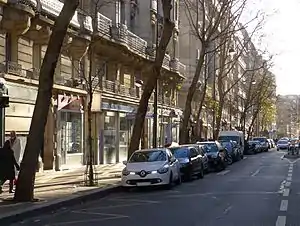 Ledru-Rollin Avenue in the 11th arrondissement.
Ledru-Rollin Avenue in the 11th arrondissement. In the 12th arrondissement, towards the Austerlitz Bridge and the Seine River.
In the 12th arrondissement, towards the Austerlitz Bridge and the Seine River.
Notable buildings
- The beginning of the Austerlitz Bridge.
- No. 33, the technical secondary school Chennevière-Malézieux.
- No. 40, the sculptures on the facade are by Émile Joseph Nestor Carlier (1849-1927).
- At the intersection with Avenue Daumesnil, the high line called Promenade plantée, developed in the late 1990s from a disused train bridge.
- No. 66, the primary entrance to the parish church St. Antoine des XV-XX.
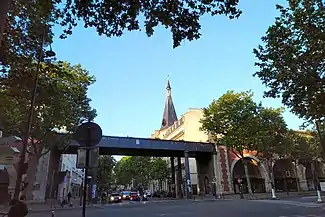 The pedestrian bridge of the "Promenade Plantée" ("Coulée Verte") traverses the avenue at the intersection of Avenue Daumesnil. The steeple of St. Antoine church is also visible.
The pedestrian bridge of the "Promenade Plantée" ("Coulée Verte") traverses the avenue at the intersection of Avenue Daumesnil. The steeple of St. Antoine church is also visible. The bell tower of St. Antoine des XV-XX church.
The bell tower of St. Antoine des XV-XX church.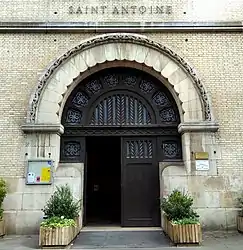 The main entrance to St. Antoine church from Ledru-Rollin Avenue.
The main entrance to St. Antoine church from Ledru-Rollin Avenue.
 Building known as the Bistrot du peintre.
Building known as the Bistrot du peintre. An overall view of the brasserie.
An overall view of the brasserie.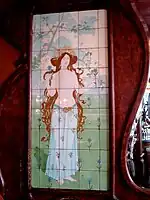 Art nouveau mosaics.
Art nouveau mosaics.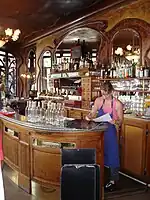 Art nouveau Brasserie.
Art nouveau Brasserie.
- At No. 153, a former Protestant church, built in 1882 by W. Hansen, is notable for the sculpture of an open Bible. This building is listed on the protected buildings of the 11th arrondissement.[2]
- At No. 160, the pastry shop La Couronne du Roi, is located, which specialises in cake design.
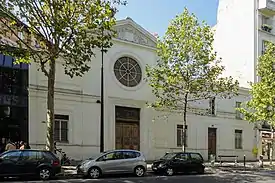 Exterior of the former Protestant church.
Exterior of the former Protestant church.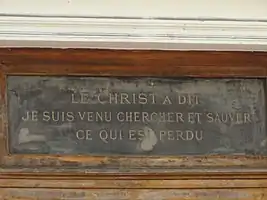 Inscription above the door of the former church.
Inscription above the door of the former church.